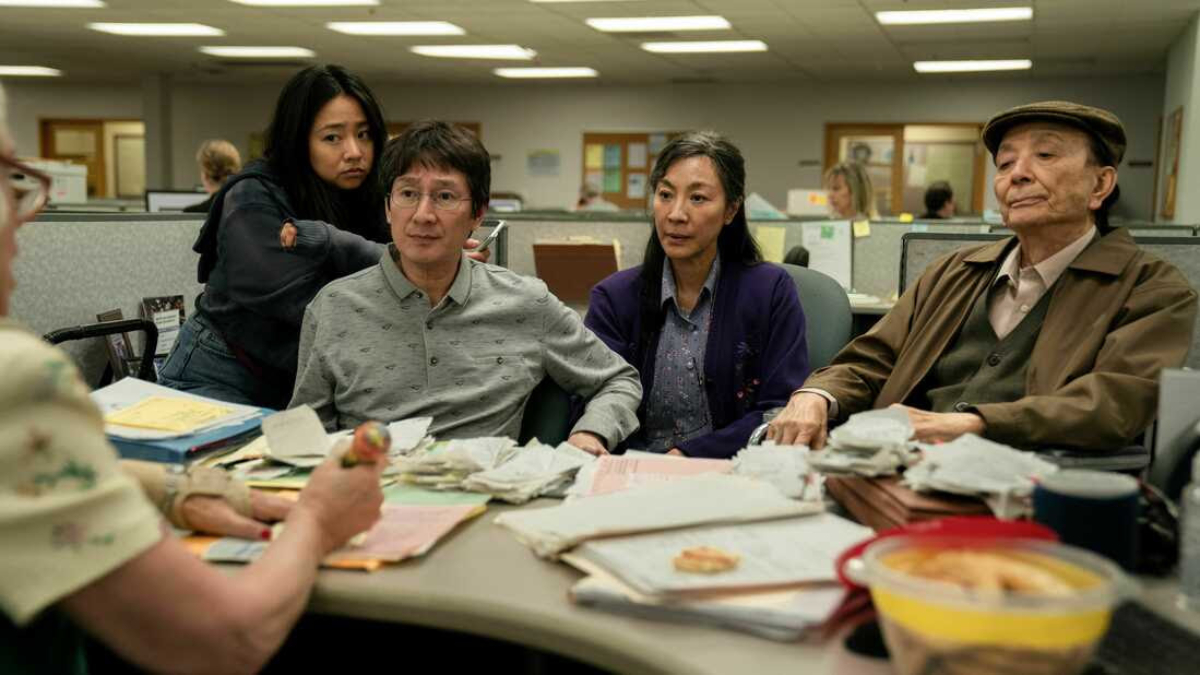This article contains spoilers.
Every so often, Hollywood releases an all-female, or all-POC version of a classic story, like the 2016 version of “Ghostbusters” or the 2014 version of “About Last Night.” And when that happens, you can bet that there will be angry people online complaining about ‘political correctness dominating the media,’ and asking why these new versions are necessary. “How is adding women or people of color to classic stories improving them?” they’ll demand to know.
As insufferable as I find these individuals due to their intention to uphold a status quo that takes representation from women and people of color, they raise an interesting point. Is simply having marginalized communities onscreen enough to make a film inclusive? Does the mere presence of an Asian person in an old story really make it better? After all, women and people of color go through the world differently than white men, so simply replacing the latter with the former in a script doesn’t fundamentally change anything. Not if the story being told is the same. At that point, you’re just driving the same car, but with a new coat of paint on it.
This was part of the criticism leveled at “Crazy Rich Asians” back in 2018 — the notion that the film, which is a loose re-telling of “Cinderella,” wasn’t really breaking new ground or saying anything true to the Asian American experience. It was just re-enacting a classic story, but with new faces, and didn’t delve into the real stuff Asian Americans deal with everyday, such as racism and xenophobia. That criticism isn’t totally unmerited. The film does tread familiar ground, and largely avoids messier topics.
This was intentional, as the director, Jon M Chu, explained in a 2019 talk with John Cho for Character Media. Chu described his movie as “a throwback sort of idea of how to create the groundwork for the movie star. To show that we could have been in any of these movies in the past. We just weren’t given the opportunity.” And that’s great, but it does lead you to wonder; once you get past the initial thrill of seeing someone who looks like you in a familiar tale, what are you left with? A familiar tale. Same story. Same morals.
So, again, is there any point in remaking older movies with more diverse leads? Well, I believe there is, and I think a perfect example of how to do it right is Daniel Kwan and Daniel Scheinert’s mind-bending sci-fi action comedy, “Everything Everywhere All At Once.” Specifically when compared to its source, Frank Capra’s “It’s A Wonderful Life.”
Now if your first thought upon reading that was “Wait, ‘Everything Everywhere All At Once’ is a remake?” The most honest answer is, “Not exactly.” I haven’t found any interviews with the Daniels citing “It’s A Wonderful Life” as an influence or inspiration. No statement by either of them about wanting to “do the story right,” or anything like that. But both films deal with themes of depression, suicide, and thwarted dreams. And the core thrust, the dramatic hook of both, is the intervention of a supernatural figure into the protagonists’ lives. The parallels are strong enough that I’m not the first person online to link the two movies. So if we can see “Everything Everywhere” as a spiritual, if not literal, remake, we’ve got to ask ourselves the one question everyone asks when a remake comes out: “Why tell the same story again?”
The simplest answer is greed. It’s easier, not to mention less risky, to adapt something people already know and have a fondness for. But I don’t think that’s the case with the Daniels, because, one, they don’t seem to have been consciously influenced by the older movie, and, two, “It’s A Wonderful Life” is an odd thing to want to remake. After all, the original film was a critical and commercial bomb when it came out back in 1946, only becoming a holiday classic after it started running on TV. It’s actually been remade a few times already, so, again, why?
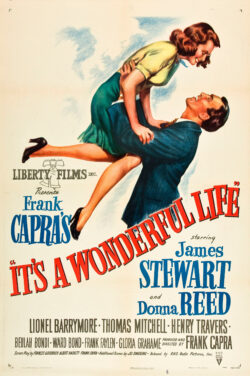
(Image Credit: IMDb)
I think it’s worth taking a step back and considering that, while lots of remakes are simply cynical attempts to cash in on recognizable brands, there are some that are not only done out of love, but necessity. Certain stories have timeless themes, but not necessarily timeless execution. For example, the 1930 version of “All Quiet On The Western Front” has a laudable anti-war message. But how it conveys that message is pretty laughable by today’s standards, what with its stiff acting, stilted dialogue, muddy sound design, and bloodless violence. If stories want to survive, to maintain their relevance and keep getting told, they need to adapt to the times. This is where “It’s A Wonderful Life” and “Everything Everywhere” come back into the picture.
While “It’s A Wonderful Life” is undoubtedly a classic, it’s also dated. I don’t just mean in the sense that it’s in black-and-white. It’s a film that’s very traditional in terms of its storytelling and ethics. There’s no swearing, there’s tons of patriotism on display, and the narrative is exclusively told from the perspective of a straight, white, Christian man, with the Christian aspect becoming very prevalent in the second half. Remember, “It’s A Wonderful Life” is the story of an angel coming down from Heaven to prevent a man from committing suicide. The picture literally begins with people praying for God to save the protagonist, George Bailey, played by Jimmy Stewart. This aspect alone narrows who the film is speaking to and for.
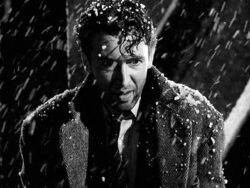
Jimmy Stewart experiences despair in “It’s A Wonderful Life.”
Likewise, I mean it when I said that the movie is told exclusively through the eyes of a straight, white man. The female characters don’t have any dreams beyond finding husbands. This is established in the first scene in which we see Mary, George’s wife, played by Donna Reed.
On top of this, there’s only one person of color in the movie — Annie, played by Lillian Randolph — who’s just there to be the sassy maid, and the film’s villain — Mr. Potter, portrayed by Lionel Barrymore — comes off as pretty cartoonish. So when you take all this into consideration — the dated presentation, the limited perspective, the oversimplified morality — you realize that “It’s A Wonderful Life” is ripe for a remake. One that has a less religious, more nuanced, more imaginative means of exploring the worthwhile themes of thwarted dreams, and finding the will to live again. Enter the Daniels.
“Everything Everywhere” addresses and improves upon every dated aspect of “It’s A Wonderful Life.” Not only is the movie made with modern techniques, but the story has a female protagonist — a Chinese immigrant named Evelyn, played by Michelle Yeoh — and the fantastical intervention is rooted in sci-fi, rather than religion. The film focuses on visitors from different universes coming to Evelyn’s reality to warn her about an impending danger. Already the scope of the story is broader, the themes are more timeless, and the stakes are more urgent.
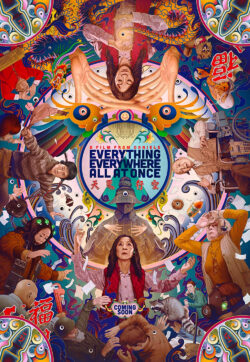
And the characterization is much more nuanced, with the lines between hero and villain being less clearly drawn. Because the film deals with the multiverse, we get to see different realities. This hopping between worlds provides spectators with a more well-rounded view of the characters and their dreams by showing, in a very literal way, that people can be many things. What’s also interesting is how, in the end, the day is saved, not with violence, but with compassion and understanding.
The film’s villain, Jobu Tupaki, aka Joy, played by Stephanie Hsu, is Evelyn’s daughter, and, in one world, her mind was broken after she was forced to experience all realities simultaneously. Now she wants to destroy the multiverse. What we realize as the story goes on, however, is that Joy/Jobu is depressed, and what she’s actually doing is reaching out to her mother. When Evelyn sees this, she realizes the way to stop the apocalypse is to embrace her daughter, let her know she’s not alone. This level of compassion and nuance is something a lot of older films lack, partially because of production codes and morality clauses contemporary to their time periods, and proves that certain stories need to be retold to achieve their full potential. They need a new perspective to maintain their power. And in the case of “Everything Everywhere,” I’m convinced these updates are a large part of why the film succeeded.
In addition to receiving rave reviews, and winning 7 Oscars, including Best Picture, the film was a huge hit at the box office, raking in over $100 million — far more than “It’s A Wonderful Life” made in its initial run. I myself watched “Everything Everywhere” twice in theaters, and a large part of that is because I saw more of myself in the Daniels’ film than I ever could in Capra’s. Not to sell “It’s A Wonderful Life” short — I still watch it with my parents every year on Christmas — but that movie is clearly the product of a different era. And the seams only get more visible as time goes by.
The film’s themes of feeling trapped, wanting more out of life, and learning to appreciate the people and things around you are timeless and universal, but the movie doesn’t make them seem that way. We understand that George Bailey has dreams that he can’t realize, but we’re never told if anyone else does, or if anyone else is unhappy. We’re never given any reason to believe that these characters have lives outside of being extras in George’s story, or that they’re more than just their archetype: evil banker, loving wife, sassy maid, etc. In “It’s A Wonderful Life,” the only people with hopes and dreams worth considering are white, American men.
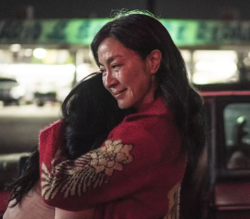
Michelle Yeoh embraces Stephanie Hsu in “Everything Everywhere All At Once.” (Image Credit: A24)
In “Everything, Everywhere” by contrast, we see multiple sides of each character, even small supporting ones. The film’s climax involves Evelyn granting each of her foes a small wish, whether it be helping two lonely souls find love, or giving a grieving widower a perfume that reminds him of his wife. This film makes it clear that everyone has desires and inner lives. Everyone is worth seeing and listening to. And that message appeals to a broader audience. That allows the film to be read in more ways than one.
So why retell old stories with new leads? To allow the themes to carry across generations, borders and backgrounds. To allow everyone to feel seen and heard. And most importantly, to make a crap ton more money off of new demographics.
In all seriousness, though, there are stories with themes that are truly universal. So why not let them actually be that?

